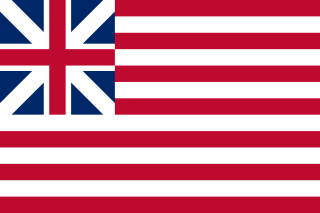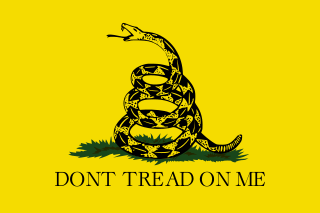
The national flag of the United States, often referred to as the American flag or the U.S. flag, consists of thirteen horizontal stripes, alternating red and white, with a blue rectangle in the canton bearing fifty small, white, five-pointed stars arranged in nine offset horizontal rows, where rows of six stars alternate with rows of five stars. The 50 stars on the flag represent the 50 U.S. states, and the 13 stripes represent the thirteen British colonies that won independence from Great Britain in the American Revolutionary War.

Annandale is a census-designated place (CDP) in Fairfax County, Virginia. The population of the CDP was 43,363 as of the 2020 United States Census. It is home to the oldest and largest branch of the Northern Virginia Community College system, and to one of the D.C. area's Koreatowns.

The flags of the Confederate States of America have a history of three successive designs during the American Civil War. The flags were known as the "Stars and Bars", used from 1861 to 1863; the "Stainless Banner", used from 1863 to 1865; and the "Blood-Stained Banner", used in 1865 shortly before the Confederacy's dissolution. A rejected national flag design was also used as a battle flag by the Confederate Army and featured in the "Stainless Banner" and "Blood-Stained Banner" designs. Although this design was never a national flag, it is the most commonly recognized symbol of the Confederacy.

The flags of the U.S. states, territories, and the District of Columbia exhibit a variety of regional influences and local histories, as well as different styles and design principles. Modern U.S. state flags date from the turn of the 20th century, when states considered distinctive symbols for the 1893 World's Columbian Exposition in Chicago, Illinois. Most U.S. state flags were designed and adopted between 1893 and World War I.

The flag of the state of Maine features Maine's state coat of arms on a blue field. In the center of a heraldic shield, a moose rests under a tall pine tree. A farmer and seaman are meant to represent the traditional reliance on agriculture and the sea by the state. The North Star is intended to allude to the state motto: dirigo.

The Commonwealth of Massachusetts has been represented by official but limited-purpose flags since 1676, though until 1908 it had no state flag per se to represent its government. A variant of the white flag with blue seal was carried by each of the Massachusetts volunteer regiments during the American Civil War alongside the National Colors. An exception were the two "Irish regiments", each of which was permitted to carry an alternative green flag with a harp symbol.

The flag of Oklahoma, also known as the Oklahoma flag, is a rectangular field of sky blue on which is placed an Osage war shield with six crosses and seven pendant eagle feathers above the word 'Oklahoma' in white. Superimposed onto the crosses of the war shield is a calumet and an olive branch.

The flag of Pennsylvania consists of a blue field on which the state coat of arms is displayed.

The flag of West Virginia is the official flag of the U.S. State of West Virginia and was officially adopted by the West Virginia Legislature on March 7, 1929. The present flag consists of a pure white field bordered by a blue stripe with the coat of arms of West Virginia in the center, wreathed by Rhododendron maximum and topped by an unfurled red ribbon reading, "State of West Virginia." It is the only state flag to bear crossing rifles, meant to illustrate the importance of the state's fight for liberty during the Civil War as the southern unionist 35th state.

Northern Virginia Community College is a public community college with six campuses and four centers in the Northern Virginia suburbs of Washington, D.C. Northern Virginia Community College is the third-largest multi-campus community college in the United States, and it is the largest educational institution in the Commonwealth of Virginia.

The Seal of the Commonwealth of Virginia is the official seal of the Commonwealth of Virginia, a U.S. state. The state flag of Virginia consists of the obverse of the seal against a blue background. A state flag was first adopted at the beginning of the American Civil War in April 1861, readopted in 1912, and standardized by the General Assembly in February 1950. The standing allegorical female figure of virtue is shown having vanquished tyranny, symbolized by a fallen king at her feet. She has an exposed breast in the manner of classical depictions of Amazons, making this the only state flag in the U.S. depicting a form of toplessness. The motto Sic semper tyrannis means "Thus always to tyrants." The flag may be decorated with a white fringe along the fly edge; this is usually done when the flag is displayed indoors.

The Continental Union Flag was the flag of the United Colonies from 1775 to 1776; and the de facto flag of the United States until 1777, when the 13 star flag was adopted by the Continental Congress.

Don't Tread on Me, usually stylized fully in uppercase letters without an apostrophe, is a political slogan dating to the American Revolution.
The Battle of Cockle Creek, October 5, 1861, was a minor naval engagement off Chincoteague, Virginia early in the American Civil War.

Sonya Clark is an American artist of Afro-Caribbean heritage. Clark is a fiber artist known for using a variety of materials including human hair and combs to address race, culture, class, and history. Her beaded headdress assemblages and braided wig series of the late 1990s, which received critical acclaim, evoked African traditions of personal adornment and moved these common forms into the realm of personal and political expression. Although African art and her Caribbean background are important influences, Clark also builds on practices of assemblage and accumulation used by artists such as Betye Saar and David Hammons.
Dennis Patrick Mullins was an American insurance salesman and served as chairman of the Republican Party of Virginia.

The flag of Phoenix, Arizona, is the official municipal flag of Phoenix, Arizona. Its current design is a maroon field with a white phoenix emblem in the center. The design is the second in the city's history and has been in place since 1990, replacing a flag that was adopted in 1921.

The municipal flag of Provo, Utah, United States, features the city's logo on a light blue field. It was adopted on January 6, 2015, after a multi-year debate to replace the previous one. The former flag, adopted in 1989, was ridiculed in particular for its perceived ugliness and its similarity to the Centrum logo, and was voted one of the worst American city flags by the North American Vexillological Association (NAVA).

The flag of Spokane, Washington, is the official municipal flag of Spokane, Washington, United States. Its design comprises a sun in the canton on a white-and-green field separated by a stylized blue river. The flag was adopted in 2021 and is the fourth to be used by the city government.

According to tradition, the first flag of the United States, the Grand Union Flag, was raised by General George Washington at Prospect Hill in Somerville, Massachusetts, on 1 January 1776, in an attempt to raise the morale of the men of the Continental Army. There was a 76-foot liberty pole situated on Prospect Hill on 22 August 1775 that "was visible from most parts of the American lines, as well as from Boston". The standard account has been questioned by modern researchers most notably Peter Ansoff, who in 2006 published a paper entitled "The Flag on Prospect Hill" where he advances the argument that Washington flew the Union Jack and not the Continental Colours that bears 13 stripes. Others, such as Byron DeLear, have argued in favour of the traditional version of events.



















